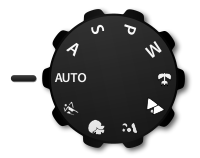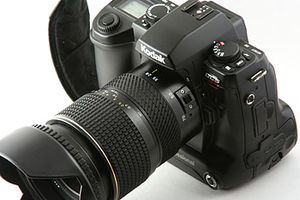
Mode dial
Encyclopedia



Digital camera
A digital camera is a camera that takes video or still photographs, or both, digitally by recording images via an electronic image sensor. It is the main device used in the field of digital photography...
s to change the camera's mode. Most digital cameras, including dSLR and SLR-like cameras, support modes, selectable either by a dial or from a menu
Menu (computing)
In computing and telecommunications, a menu is a list of commands presented to an operator by a computer or communications system. A menu is used in contrast to a command-line interface, where instructions to the computer are given in the form of commands .Choices given from a menu may be selected...
. On point-and-shoot cameras which support modes a range of scene types is offered. On dSLR cameras and SLR-like cameras, mode dials usually offer access to manual settings. The more compact point-and-shoot cameras, and cameras offering a great many modes, do not have mode dials, using menus instead. Some SLR lenses themselves offer control over things such as aperture, reducing the need for mode support in the camera body.
Location of the dial
On most dSLRs and SLR-like bridge cameras, the mode dial is located at the top of the camera, to one side of the flash/viewfinder hump. On point-and-shoot cameras, however, the mode dial's location is less standard. On many models, it is found on top like dSLRs. On other point-and-shoots, particularly those with a thin body, the dial is found on the back of the camera, often coupled with a menu-navigation button. Some thin cameras use a slide switch rather than a dial.Modes
Various camera types and specific cameras have different modes. The simpler dial in the top illustration has:- Manual modes: Manual (M), Program (P), Shutter priority (S), Aperture priority (A).
- Automatic modes: Auto, Action, Portrait, Night portrait, Landscape, Macro.
Most dSLRs have a few manual settings and a small sample of automatic modes. Most SLR-like cameras have manual modes and several automatic scene modes. On point-and-shoot cameras, all manual control may be condensed into one mode (e.g. ASP, for Aperture priority, Shutter priority, Program) or may be completely absent. Many compact cameras show a large array of scene modes. Point-and-shoot and SLR-like digital cameras usually have a movie mode to capture videos, but the design of dSLRs prevents them from having movie modes.
Detailed information found by users on the modes supported by digital cameras are to be found in the ongoing list of digital camera modes.
Manual modes
Manual modes include:- P: Program mode offers partial control over shutter speedShutter speedIn photography, shutter speed is a common term used to discuss exposure time, the effective length of time a camera's shutter is open....
and apertureApertureIn optics, an aperture is a hole or an opening through which light travels. More specifically, the aperture of an optical system is the opening that determines the cone angle of a bundle of rays that come to a focus in the image plane. The aperture determines how collimated the admitted rays are,...
. - A or Av: Aperture priorityAperture priorityAperture priority, often abbreviated A or Av on a camera mode dial, is a setting on some cameras that allows the user to choose a specific aperture value while the camera selects a shutter speed to match. The camera will ensure proper exposure...
controls the aperture, and the shutter is calculated by the camera. - S or Tv: Shutter priorityShutter priorityShutter priority refers to a setting on some cameras that allows the user to choose a specific shutter speed while the camera adjusts the aperture to ensure correct exposure...
controls the shutter speed, and aperture is calculated by the camera. - M: Manual mode controls shutter speed and aperture independently.
Automatic scene modes
In automatic modes the camera determines all aspects of exposure, choosing exposure parameters according to the application within the constraints of correct exposure, including exposureExposure (photography)
In photography, exposure is the total amount of light allowed to fall on the photographic medium during the process of taking a photograph. Exposure is measured in lux seconds, and can be computed from exposure value and scene luminance over a specified area.In photographic jargon, an exposure...
, aperture
Aperture
In optics, an aperture is a hole or an opening through which light travels. More specifically, the aperture of an optical system is the opening that determines the cone angle of a bundle of rays that come to a focus in the image plane. The aperture determines how collimated the admitted rays are,...
, focus
Focus (optics)
In geometrical optics, a focus, also called an image point, is the point where light rays originating from a point on the object converge. Although the focus is conceptually a point, physically the focus has a spatial extent, called the blur circle. This non-ideal focusing may be caused by...
sing, light meter
Light meter
A light meter is a device used to measure the amount of light. In photography, a light meter is often used to determine the proper exposure for a photograph...
ing, white balance, and equivalent sensitivity. For example in portrait mode the camera would use a wider aperture to render the background out of focus, and would seek out and focus on a human face rather than other image content. In the same light conditions a smaller aperture would be used for a landscape, and recognition of faces would not be enabled for focussing.
Some cameras have tens of modes, showing the majority only in the menu rather than on the dial. Many cameras do not document exactly what their many modes do; for full mastery of the camera one must experiment with them.
In general:
- Action or sport mode increases ISO and uses a fast shutter speed to capture action.
- Landscape mode uses a small aperture to gain depth of fieldDepth of fieldIn optics, particularly as it relates to film and photography, depth of field is the distance between the nearest and farthest objects in a scene that appear acceptably sharp in an image...
. - Portrait mode widens the aperture to throw the background out of focus. The camera may recognise and focus on a human face.
- Night portrait mode uses an exposure long enough to capture background detail, with fill-in flashFlash (photography)A flash is a device used in photography producing a flash of artificial light at a color temperature of about 5500 K to help illuminate a scene. A major purpose of a flash is to illuminate a dark scene. Other uses are capturing quickly moving objects or changing the quality of light...
to illuminate a nearby subject.
Other scene modes found on many cameras include Fireworks, Snow, Natural light/Night snapshot, Macro/Close-up, and Movie mode.
See also
- List of digital camera modes
- Shutter priorityShutter priorityShutter priority refers to a setting on some cameras that allows the user to choose a specific shutter speed while the camera adjusts the aperture to ensure correct exposure...
- Aperture priorityAperture priorityAperture priority, often abbreviated A or Av on a camera mode dial, is a setting on some cameras that allows the user to choose a specific aperture value while the camera selects a shutter speed to match. The camera will ensure proper exposure...
- Digital cameraDigital cameraA digital camera is a camera that takes video or still photographs, or both, digitally by recording images via an electronic image sensor. It is the main device used in the field of digital photography...
- Digital SLR

